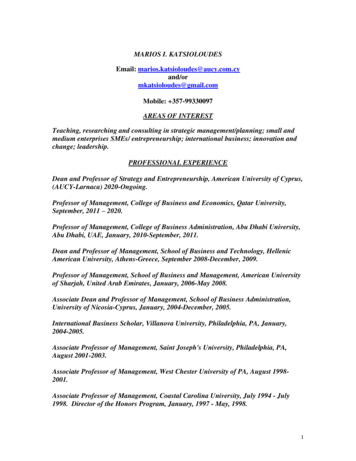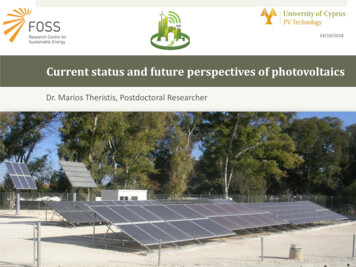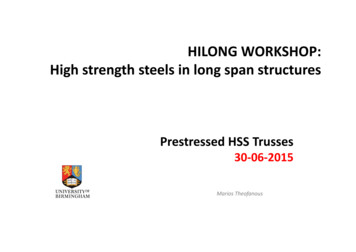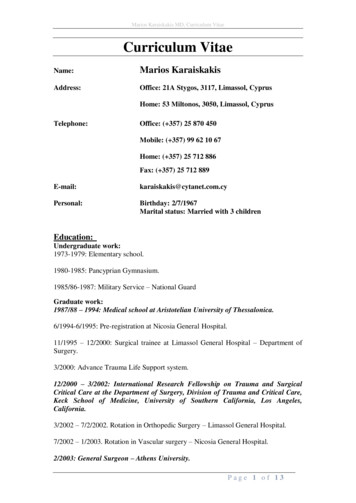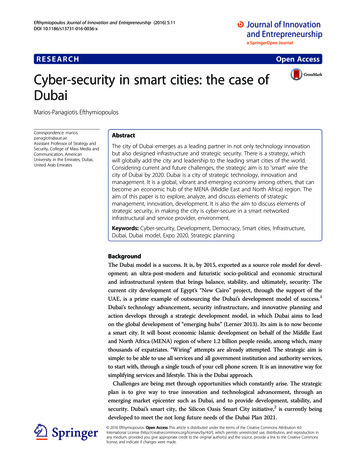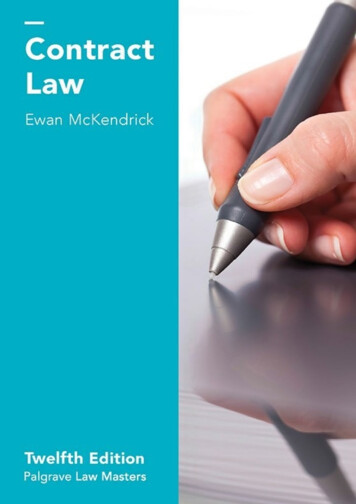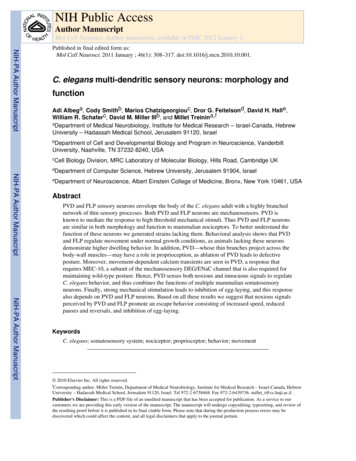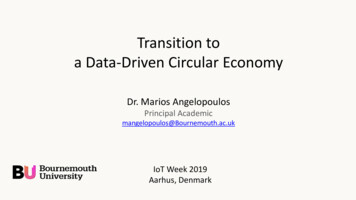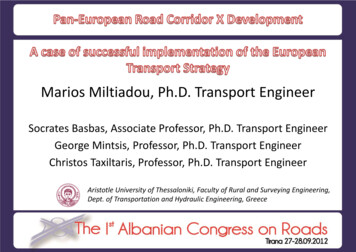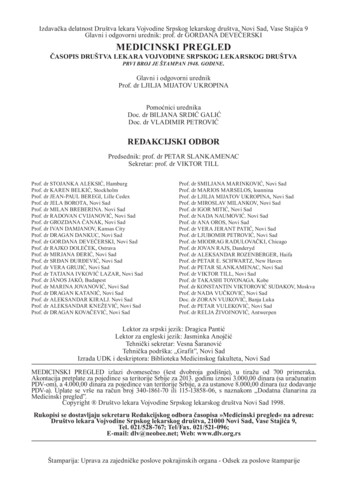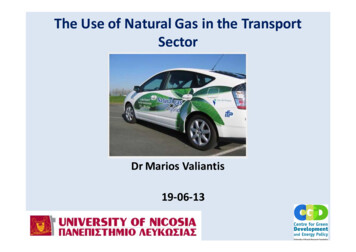
Transcription
The Use of Natural Gas in the TransportSectorDr Marios Valiantis19‐06‐13
Transport SectorThe transport sector is the driving force of the moderneconomy.The needs in passenger and freight transportation areincreasing at rates greater than the economy and populationgrowth.Existing transport systems cannot be characterizedsustainable long term.
Transport Sector ‐ EuropeEurope is heavily depended on imported oil for its mobility andtransport.2010 – oil accounted for 94% of energy consumed in transport 84% of it is imported with a bill of up to 1 billion euro a day in2011 . leading to a significant deficit in the EU trade balance of around2.5% of GDP.The effect of the oil dependence in the European economy is toolarge to neglect.Replacing oil with alternative fuels and build up the necessaryinfrastructure could bring huge savings on the oil import bill.
Road Transport ‐ EuropeContributes about 20% of the EU’s total CO2 emissions.CO2 emissions increased by nearly 23% between 1990 and 2010,and without the economic downturn growth it could have beeneven bigger.Light‐duty vehicles (cars and vans) are producing around 15% of theEU’s CO2 emissions.Transport is the only sector in the EU where GHG emissions are stillrising.
European Legislation ‐ 20072007 – Comprehensive Legal Framework to reduce CO2 emissionsfrom new light‐duty vehicles as part of the efforts to ensure itmeets its GHG emission reduction targets.The legislation sets binding emissions targets for new car and vanfleets.
European Legislation – 2007Cars: manufacturers are obliged to ensure that their new car fleetdoes not emit more than an average of 130 g. CO2/km by 2015 and95 g. CO2 /km by 2020.This compares with and average of almost 160 g. CO2 / km in 2007and 135.7 g. CO2 / km in 2011.Fuel consumption:5.6 l/100 km of petrol or 4.9 l/100 km of diesel by 20154.1 l/100 km of petrol or 3.6 l/100 km of diesel by 2020
European Legislation – 2007Vans: manufacturers are obliged to ensure that their new van fleetdoes not emit more than an average of 175 g. CO2/km by 2017 and147 g. CO2 /km by 2020.This compares with and average of almost 203 g CO2 / km in 2007and 181.4 g. CO2 / km in 2010.Fuel consumption:7.6 l/100 km of petrol or 6.6 l/100 km of diesel by 20176.3 l/100 km of petrol or 5.5 l/100 km of diesel by 2020
Europe 2020 StrategyTowards a smart, sustainable and inclusive growth 20% Savings in total primary energy consumption by 2020. 20% reduction in greenhouse gas emissions compared with 1990levels by 2020. 20% percentage contribution of renewable energy in total energyconsumption by 2020.
2011 ‐ White Paper ‐ TransportationRoadmap to a Single European Transport AreaTowards a Competitive and Resource Efficient Transport System
Future Challenges of Transport inEuropeGrowing congestion and very little accessibilityDependence on oil and increase of oil pricesThe need to reduce carbon dioxide emissions.
Goals Towards a Competitive and ResourceEfficient Transport SystemThese 10 goals are the benchmark for achieving the 60% reduction inGHG emissions.Developing and deploying new and sustainable fuelsand propulsion systemsOptimizing the performance of multimodal logisticchains, including making greater use of more energy‐efficient modesIncreasing the efficiency of transport and ofinfrastructure use with information systems and market‐based incentives
Halve the use of ‘conventionally fuelled‘ cars in urban transportby 2030; phase them out in cities by 2050; achieve essentiallyCO2‐free city logistics in major urban centers by 2020.
Energy Consumption – Cyprus (ktoe)
Commitments of Cyprus to theEuropean Strategy 20% Savings in total primary energy consumption by 2020. 20% reduction in greenhouse gas emissions compared with 1990levels by 2020. Increase in the percentage contribution of renewable energy intotal energy consumption to 13% by 2020. Increase in the percentage uptake of renewable energy intransportation by 10% by 2020.
Commitments of Cyprus to Climate andEnergyAs a Member State of the EU, Cyprus has undertaken the followinggoals for emissions reduction within the legislative package of‘Climate and Energy’: Reduction in greenhouse gas emissions by 21% by 2020 withreference to 2005 in the premises covered by the Emissions TradingScheme (power plants, cement plants and ceramics plants). Reduction in greenhouse gas emissions by 5% by 2020 withreference to 2005 from sectors not included in the EmissionsTrading Scheme (transport, agriculture, waste and housing).
The Use of Natural Gas in the TransportSectorNatural Gas can be used in transportation in 3 forms: Compressed Natural Gas (CNG) Liquefied Natural Gas (LNG) Gas to Liquid(GTL)
CNGNatural gas under pressure which remains clear odorless and non‐corrosive.Can be used in cars, urban fleets of buses, utility trucks and taxisOne third the price of a gallon of gasolineCleaner fuel than gasoline:CO reduction by 90%NOX reduction by 35‐60%GHG reduction by 20‐30%
LNGNatural gas in liquid form.High energy density offers a cost‐efficient alternative to diesel fortrucks and rail, with lower pollutant and CO2 emissions.Particularly suited for long‐distance road freight transport for whichalternatives to diesel are extremely limited.LNG is also an attractive fuel option for vessels in particular to meetthe new sulphur content in marine fuels decreasing from 1% to0.1% from 1 January 2015 in Sulphur Emission Control Areas(SECAs) in the Baltic Sea, North Sea, and English Channel, as set bythe International Maritime Organisation (IMO).
GTLGTL is another liquefaction process gaining interest and investmentin recent years.GTL turns natural gas into a clean burning diesel fuel.GTL fuel ignite more easily thanconventional fuels, improving theperformance of the car engine andreducing the emissions.
Natural Gas Vehicle Market (NGV) in EuropeAround 1 million vehicles onthe road in EuropeAround 3000stationsfilling
NGV Notable GrowthSource: NGV America ‐ 2012
World Wide NGV Growth Actual / ProjectedSource: NGV America ‐ 2012
International Vehicle AvailabilityEvery major car manufacturer is making natural gas vehicles forsome marker oyotaCitroenFiatSkoda
The Chicken and Egg ProblemEU launched in January 2013 the Clean Fuel Strategy: ambitiouspackage to ensure the build‐up of alternative fuel stations acrossEurope.The three main barriers: relatively higher cost of vehicles relatively lower level of consumer acceptance lack of refueling stations
Why Should We Invest in NGVs? We will have the fuel domestically NGVs are a Here‐and‐Now Technology More NGVs – more jobs Substantial Air Quality Benefits: Urban Pollution Substantial Environmental Benefits: GHGs Substantial Environmental Benefits: GHGs Government subsidies / benefits Long term economic benefits
Thank YouDr Marios ValiantisDirector of Centre for Green Development and Energy PolicyHead ‐ BSc Environmental ManagementHead ‐ MBA ‐ Oil, Gas and Energy ManagementHead ‐ BBA Energy, Oil and Gas ManagementUniversity of Nicosia46 Makedonitissas Ave.P.O. Box 24005, 1700NicosiaTel: 357 22841689 Fax: 357 22355116Email: valiantis.m@uni.ac.cyWebsite: www.unic.ac.cy
European Legislation - 2007 Cars:manufacturers are obliged to ensure that their new car fleet does not emit more than an average of 130 g. CO2/km by 2015 and 95 g. CO2 /km by 2020. This compares with and average of almost 160 g.
